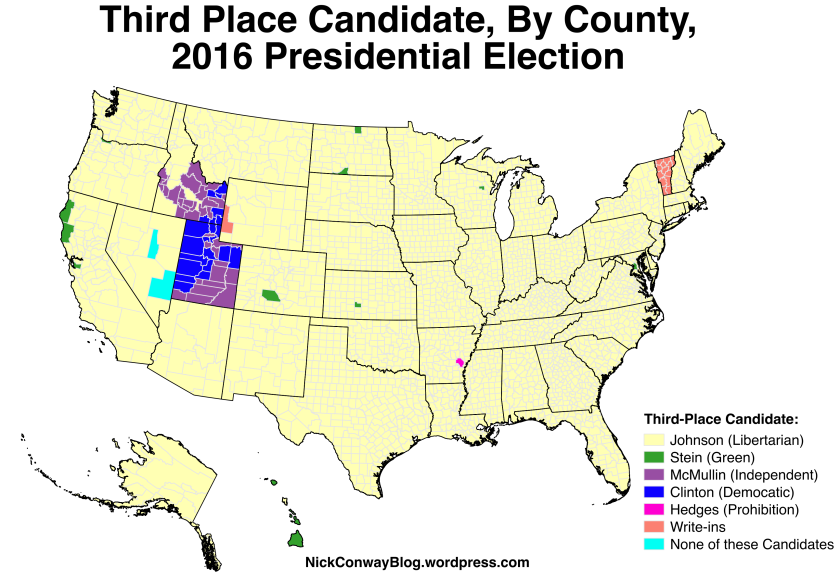
The map above uses preliminary results from the 2016 US presidential election to show the third-place finisher in the presidential election in each county. In almost every county the top two candidates were Donald Trump and Hillary Clinton (with the exception of several extremely conservative and heavily mormon counties in Utah and Idaho where Hillary fell to third behind Independent Evan McMullin).
The Libertarian ticket of former New Mexico Governor Gary Johnson and former Massachusetts Governor William Weld received 3.3% of the nationwide popular vote, over 4 million votes total, which was by far the strongest performance of a third-party this year. It was also the best result for a third-party since Ross Perot’s Reform Party run in 1996. This success is evident on the map, as the Johnson ticket reached third-place in the vast majority of counties in the US.
Jill Stein of the Green Party came in fourth in the national popular vote with 1.3 million votes (1%). She was only able to reach third-place in a handful of counties. Among these were several major cities, including Portland, San Francisco, Oakland, and New York City (she had more votes than Johnson in every borough except Staten Island). She was also the strongest third-party candidate on most of the islands of Hawaii (and the San Juan islands of Washington state), part of the northern coast of California (Humboldt and Mendocino counties), and two Native American reservations in North Dakota and one reservation in Wisconsin, along with a couple of other counties.
Evan McMullin is an interesting case. He ran as an independent conservative, hoping to gain the votes of Republicans who were unhappy with Donald Trump. However, he entered the race late and was unable to get on the ballot in most states. Additionally, Republican voters ended up coming home to the party, voting in strong numbers for Trump. McMullin, who is LDS, ended up as the “mormon candidate”. Trumps was unpopular among the conservative Mormon population, which allowed McMullin to pull 21% of the vote in Utah and 7% in Idaho. Nationally, he came in fifth, receiving only 0.4% of the vote, but he came closest of any third-party candidate to capturing a state. McMullin actually placed second in several counties in Utah and Idaho, beating Hillary Clinton in those areas, though he placed third overall in both states. Donald Trump did not fall to third in any counties, though he came closest in the District of Columbia, where he received 4% of the vote and write-in’s received 2.5%.
This year also saw an uptick in the number of “write-in” votes. For example, write-ins dominated the third-party vote in Vermont, and these votes were almost certainly for the state’s own Senator Bernie Sanders. Almost 8% of Vermont voters wrote-in a presidential candidate on their ballot. Write-ins also placed third in one county in western Wyoming, and in the District of Columbia.
Nevada is the only state with a “None of these Candidates” option on the ballot, and it got 2.6% of the vote in that state and won third-place in two rural Nevada counties.
Finally, the Prohibition Party’s candidate, James Hedges, received 5,565 votes nationwide (apparently the best showing for the Prohibition Party since 1988), which comes to 0.00004% of the national vote. Nonetheless, despite this tiny showing, James Hedges somehow came in third in Arkansas County, Arkansas, with 133 votes, beating Gary Johnson’s total by 7 votes.
Several other third-parties ran candidates, such as the Constitution Party (0.14% of the vote) and the Party of Socialism and Liberation (0.04% of the vote), but none of these parties finished third in any counties.